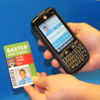
Cleveland Schools Take P.R.I.D.E in New Security System
- By Cindy Horbrook
- Nov 21, 2011
When students and faculty in the Cleveland Metropolitan School District returned from summer break this year, they were greeted with increased security on campus.
The CMSD has instituted the P.R.I.D.E. (Priority Recognition Increased Data and Efficiency) initiative, which consists of three components: student identification badges, visitor management and a student information/discipline management system.
Lester Fultz, the district’s chief of safety and security, said in late 2007 the district adapted a new strategy called “humanware hardware.” The hardware portion involved making the campuses safer, so the district increased its staff of security officers and deployed metal detectors and x-ray machines in the buildings. The district then turned to IDentiphoto, who put together a team to come up with a solution for CMSD’s identification needs.
“They were looking for a combination of a couple products, one of which was student IDs. The other was bar code readers. Rather than just say here’s your quote for each product, we met with all the entrusted parties with CMSD to identify exactly what they were trying to accomplish,” said Geoffrey Urbanowski, IDentiphoto’s lead ID consultant and CMSD project manager.
The district had tried to implement student IDs in the past, but were unsuccessful because students often would not carry them.
“We said ‘What can we make an ID card do?’ That’s how we came up with the options we’re using for this program now,” Fultz said. “Our ID card has a lot of intrinsic value for our students. There will be a day, when we fully implement this throughout our 100 schools, that a kid will not leave home without that ID card.”
Evenually, the student ID will be a meal card, media card and transportation card, and it will take attendance at the front door, according to Fultz.
“Those things make it necessary for students to bring their ID card everyday,” Fultz said.
The system uses existing technology—mainly bar code technology and mobile computers. The mobile computers connect to mobile printers via Bluetooth.
“The beauty of utilizing bar codes is it allows the student ID card to be used in a variety of systems, so it crosses platforms,” said Pamela Johnson-Acey, IDentiphoto’s COO. “The same card used in the library is the same card used in the lunch room.”
The system’s visitor management interface allows a visitor to his or her scan driver’s license or state ID upon arriving at the school, which enables the district to instantly verify the person’s identity. Scanning the driver’s license also allows for the checking of various watch lists, such as the national sexual predator list and the district’s internal watch list. Upon approval, the visitor is then printed out a temporary visitor badge to wear while on the premises. All this takes about 30 seconds.
“Prior (to this), what they did was the person came in and signed on a line in the guest log,” Urbanowski said. “So there was no verification of who they said they were.”
IDentiphoto’s system also includes a handheld device that can instantly scan a student ID or allows a user to look up a student up by ID number or by their first or last name.
“That handheld device pulls up all their information—it pulls up a photo of them, their name, their schedule as well as any past disciplinary history they might have,” Urbanowski said.
ID cards are currently in use in all 100 of the district schools, with implementation for the media, lunch room and transportation portions and the visitor management aspects as funding allows.
“We really believe that our strategy will improve the academics, the learning (and) the graduation rate for our students,” Fultz said. “If we can provide a safe teaching and learning environment for our students, we can improve their success in school.”
Fultz said the reaction among the district has been surprisingly positive from staff and students.
“The kids, especially the little girls, wanted to make sure their picture was pretty…that was really very heartwarming to see the buy in from our students. The process is very simple. Its not going to be an intrusion on our day. We don’t anticipate it will make the process of entering our building any longer or any more uncomfortable for our students,” Fultz said. “We really have seen very little pushback, in fact just the opposite. In the buildings that we have not instituted the process, a lot of principals are asking ‘Can I be next?’ They have been very willing to help us move the project forward.”